Related Research Articles
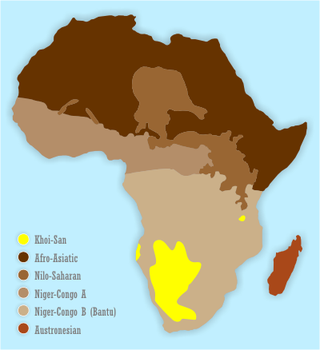
The Khoisan languages are a number of African languages once classified together, originally by Joseph Greenberg. Khoisan is defined as those languages that have click consonants and do not belong to other African language families. For much of the 20th century, they were thought to be genealogically related to each other, but this is no longer accepted. They are now held to comprise three distinct language families and two language isolates.

The Kordofanian languages are a geographic grouping of five language groups spoken in the Nuba Mountains of the South Kordofan region of Sudan: Talodi–Heiban languages, Lafofa languages, Rashad languages, Katla languages and Kadu languages. The first four groups are sometimes regarded as branches of the hypothetical Niger–Congo family, whereas Kadu is now widely seen as a branch of the proposed Nilo-Saharan family.

The Nilo-Saharan languages are a proposed family of around 210 African languages spoken by somewhere around 70 million speakers, mainly in the upper parts of the Chari and Nile rivers, including historic Nubia, north of where the two tributaries of the Nile meet. The languages extend through 17 nations in the northern half of Africa: from Algeria to Benin in the west; from Libya to the Democratic Republic of the Congo in the centre; and from Egypt to Tanzania in the east.

The Nilotic languages are a group of related languages spoken across a wide area between South Sudan and Tanzania by the Nilotic peoples.
The Adamawa languages are a putative family of 80–90 languages scattered across the Adamawa Plateau in Central Africa, in northern Cameroon, north-western Central African Republic, southern Chad, and eastern Nigeria, spoken altogether by only one and a half million people. Joseph Greenberg classified them as one branch of the Adamawa–Ubangi family of Niger–Congo languages. They are among the least studied languages in Africa, and include many endangered languages; by far the largest is Mumuye, with 400,000 speakers. A couple of unclassified languages—notably Laal and Jalaa—are found along the fringes of the Adamawa area.
The Western Nilotic languages are one of the three primary branches of the Nilotic languages, along with the Eastern Nilotic languages and Southern Nilotic languages; Themselves belonging to the Eastern Sudanic subfamily of Nilo-Saharan. The about 22 Western Nilotic languages are spoken in an area ranging from southwestern Ethiopia and South Sudan via northeastern Democratic Republic of the Congo and northern Uganda to southwestern Kenya.
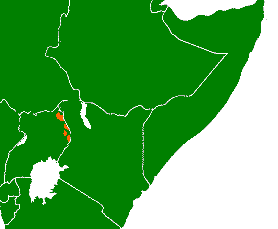
The Kuliak languages, also called the Rub languages, are a group of languages spoken by small relict communities in the mountainous Karamoja region of northeastern Uganda.

In most classifications, the Eastern Sudanic languages are a group of nine families of languages that may constitute a branch of the Nilo-Saharan language family. Eastern Sudanic languages are spoken from southern Egypt to northern Tanzania.
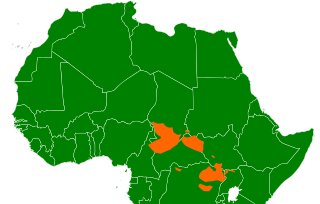
Central Sudanic is a family of about sixty languages that have been included in the proposed Nilo-Saharan language family. Central Sudanic languages are spoken in the Central African Republic, Chad, Sudan, South Sudan, Uganda, Congo (DRC), Nigeria and Cameroon. They include the pygmy languages Efé and Asoa.
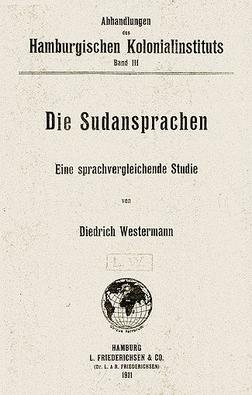
In early 20th century classification of African languages, Sudanic was a generic term for languages spoken in the Sahel belt, from Ethiopia in the east to Senegal in the west.
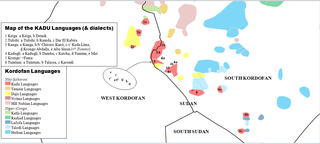
The Kadu languages, also known as Kadugli–Krongo or Tumtum, are a small language family of the Kordofanian geographic grouping, once included in Niger–Congo. However, since Thilo Schadeberg (1981), Kadu is widely seen as Nilo-Saharan. Evidence for a Niger-Congo affiliation is rejected, and a Nilo-Saharan relationship is controversial. A conservative classification would treat the Kadu languages as an independent family.
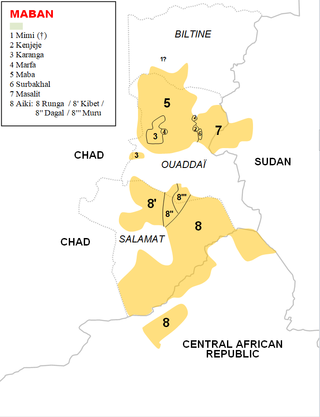
The Maban languages are a small family of languages which have been included in the hypothetical Nilo-Saharan language family.
The Mararit language is a Taman language of the Eastern Sudanic branch spoken in eastern Chad and western Sudan. There are two dialects, Ibiri and Abou Charib, which Blench (2006) counts as distinct languages. The majority speak the Abou Charib dialect. Mararit is reportedly not mutually intelligible with Tama and Sungor despite being part of the same Taman language group.

The Ekoid languages are a dialect cluster of Southern Bantoid languages spoken principally in southeastern Nigeria and in adjacent regions of Cameroon. They have long been associated with the Bantu languages, without their status being precisely defined. Crabb (1969) remains the major monograph on these languages, although regrettably, Part II, which was to contain grammatical analyses, was never published. Crabb also reviews the literature on Ekoid up to the date of publication.
The Huon languages are a language family, spoken on the Huon Peninsula of Papua New Guinea, that was classified within the original Trans–New Guinea (TNG) proposal, and William A. Foley considers their TNG identity to be established. They share with the Finisterre languages a small closed class of verbs taking pronominal object prefixes some of which are cognate across both families, strong morphological evidence that they are related.
The Northern Eastern Sudanic, Eastern k Sudanic, Ek Sudanic, NNT or Astaboran languages may form a primary division of the proposed Eastern Sudanic family. They are characterised by having a /k/ in the first person singular pronoun "I/me", as opposed to the Southern Eastern Sudanic languages, which have an /n/. Nyima has yet to be conclusively linked to the other languages, and would appear to be the closest relative of Ek Sudanic rather than Ek Sudanic proper.
The Southern Eastern Sudanic, Eastern n Sudanic, En Sudanic languages form one of two primary divisions of the Eastern Sudanic languages in the classification of Bender (2000). It is rejected as an established group in Starostin (2015).
Tese (Teisei) is an Eastern Sudanic language spoken in the Nuba Hills of Sudan.
Keiga Jirru is an Eastern Sudanic language spoken in the Nuba Hills of Sudan.
Kresh is a small language group of South Sudan. It is generally considered to be a branch of the Central Sudanic languages. Boyeldieu (2010) judges that this has yet to be demonstrated satisfactorily, but Starostin (2016) finds convincing evidence, and that its closest relative within that family appears to be Birri.
References
- ↑ Starostin, George (2015). Языки Африки. Опыт построения лексикостатистической классификации. Том II. Восточносуданские языки[The Languages of Africa: A New Lexicostatistical Classification.] (in Russian). Vol. II: The Eastern Sudanic Languages. Moscow: Languages of Slavic Culture. ISBN 9785457890718.
- ↑ Starostin, George (2015) The Eastern Sudanic hypothesis tested through lexicostatistics: current state of affairs (Draft 1.0)
- ↑ Hammarström, Harald; Forkel, Robert; Haspelmath, Martin; Bank, Sebastian, eds. (2016). "Western Nilotic". Glottolog 2.7. Jena: Max Planck Institute for the Science of Human History.
- ↑ Nilo-Saharan list (Blench 2012)